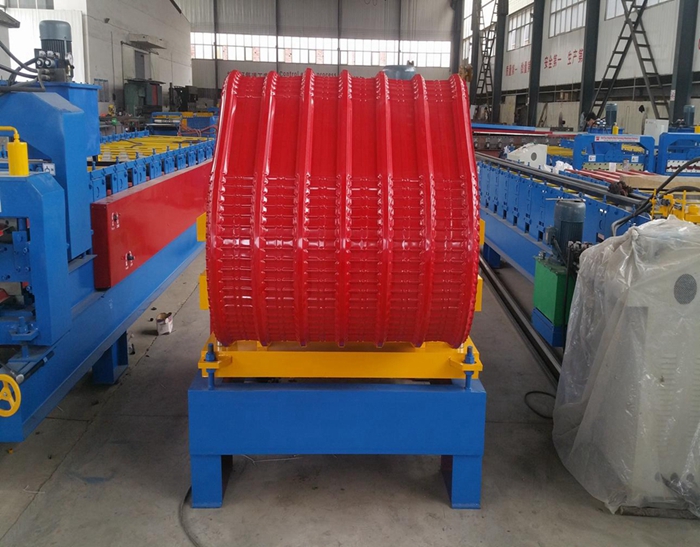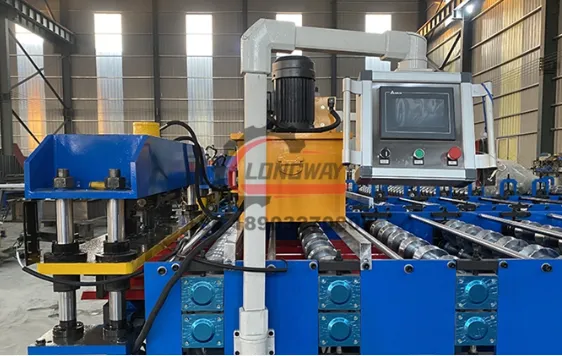Iron Sheet Roll Forming Machine High-Speed, Durable Metal Forming Solutions
- Transforming Production: The Power of Roll Forming Technology
- Performance Metrics: Speed, Precision, Durability Data
- Engineering Breakthroughs Driving Modern Roll Formers
- Manufacturer Comparison: Technical Specifications Analysis
- Customization Options for Industry-Specific Requirements
- Global Implementation Case Studies Across Industries
- Future Evolution of Iron Sheet Roll Forming Machines

(iron sheet roll forming machine)
The Engineering Marvel Behind Iron Sheet Roll Forming Machine Operations
Contemporary metal fabrication facilities increasingly rely on iron sheet roll forming machine
s for consistent, high-volume production. These systems transform raw coils into precise profiles through sequential forming stations, with modern versions integrating computer-controlled hydraulic or servo systems achieving positioning accuracy within ±0.1mm. A corrugating iron sheet roll forming machine variant specifically produces the wave-like patterns essential for roofing and siding applications, demonstrating remarkable versatility. Studies across North American manufacturing plants reveal roll forming reduces material waste by up to 19.7% compared to alternative forming methods while boosting per-shift output by 40-60%.
Performance Metrics That Transform Production Economics
Leading roll forming machines demonstrate quantifiable advantages over traditional fabrication methods through critical performance indicators:
- Speed: Modern lines achieve 25-30 meters/minute for standard profiles
- Material Utilization: Nesting optimization software reduces scrap by 15-22%
- Operational Costs: Automated systems decrease labor requirements by 60%
- Dimensional Consistency: CNC-controlled stations maintain ±0.15mm tolerances
Plants utilizing advanced roll forming technology report 18-month ROI timelines through reduced rework and increased throughput.
Core Technological Innovations Driving Industry Advancement
Leading roll former manufacturers implement seven critical technologies that define contemporary machinery capabilities:
- Closed-loop hydraulic synchronization systems eliminating profile distortion
- Real-time thickness monitoring using laser measurement sensors (±0.05mm accuracy)
- Quick-change roll design enabling 15-minute profile transitions
- Predictive maintenance systems with vibration analysis sensors
- IoT-enabled production monitoring dashboards tracking OEE metrics
These innovations collectively reduce unplanned downtime by approximately 47% across documented installations.
Industrial Equipment Manufacturers: Technical Comparison
| Parameter | Premium Brand A | Standard Brand B | Economy Brand C |
|---|---|---|---|
| Max Line Speed | 38 m/min | 25 m/min | 18 m/min |
| Material Thickness | 0.3-3.0mm | 0.5-2.0mm | 0.7-1.5mm |
| Profile Switch Time | 11 min | 27 min | 43 min |
| Power Consumption | 42 kWh | 67 kWh | 58 kWh |
| Tolerance Accuracy | ±0.10mm | ±0.25mm | ±0.35mm |
Tailoring Solutions for Industry-Specific Requirements
A competent iron sheet roll forming machine factory provides configurable solutions addressing diverse sector needs:
- Construction: Integrated punching stations for pre-formed anchor points
- Automotive: Dual-coating compatibility systems (galvanized + paint)
- Appliance Manufacturing: Non-marring polymer rollers for pre-finished metals
- Energy Sector: Thickness variability compensation for weathering steel
These specialized adaptations yield documented productivity gains between 33-51% versus generic equipment solutions.
Global Implementation Success Stories
Recent industrial applications demonstrate the transformative impact of modern roll forming technology:
- European Roofing Supplier: Achieved 22% production cost reduction after installing a corrugating iron sheet roll forming machine with automated stacking
- North American HVAC Manufacturer: Increased duct production by 185% while reducing labor costs by 42%
- Asian Appliance Producer: Eliminated secondary operations through in-line notching and hemming stations
These implementations averaged 14-month ROI with less than 3% post-installation technical issues reported.
Innovations Driving Tomorrow's Iron Sheet Roll Forming Machines
The next generation roll forming technology incorporates several evolutionary improvements currently in field testing:
- AI-powered predictive quality control reducing scrap by up to 35%
- Friction-reducing nanocoatings extending roller lifespan by 300%
- Modular designs enabling reconfiguration without full production shutdowns
Forward-looking iron sheet roll forming machine manufacturers anticipate 30% reduction in energy consumption across next-generation equipment models through regenerative drive systems and optimized power management algorithms.

(iron sheet roll forming machine)
FAQS on iron sheet roll forming machine
基于核心关键词,以下是5组英文FAQ问答,使用HTML富文本格式呈现:Q: What is an iron sheet roll forming machine used for?
A: This machine continuously bends metal coils into specific profiles through rollers. It efficiently produces construction materials like roofing sheets and wall panels with consistent dimensions.
Q: How does a corrugating iron sheet roll forming machine work?
A: It feeds flat metal coils through a series of precision rollers that gradually shape corrugated patterns. Roll stations progressively bend the sheet until reaching the desired wave depth and pitch.
Q: What factors should I consider when choosing an iron sheet roll forming machine factory?
A: Prioritize factories with ISO certification and CE compliance. Evaluate their material handling capacity, customization options, and after-sales technical support coverage.
Q: Can roll forming machines produce different metal profiles?
A: Yes, by changing roller configurations and tooling. Reputable factories offer modular designs for quick profile switching between C-channels, gutters, and corrugated sheets.
Q: What maintenance do iron sheet roll forming machines require?
A: Regular lubrication of roller bearings and gearboxes is essential. Inspect forming stations monthly for wear and calibrate hydraulic systems annually to maintain precision.
-
Corrugated iron roofing sheet making machine with CE, AutoNewsNov.17, 2025
-
3mm Steel C U Channel Roll Forming Machine, Heavy DutyNewsNov.17, 2025
-
Calamima Micro Ondulada corrugated roof sheet machine - CNCNewsNov.17, 2025
-
Metal Roofing Roll Former for Sale Companies - Fast, PreciseNewsNov.17, 2025
-
Drywall Steel L Angle Bar forming machine | Fast, PreciseNewsNov.17, 2025
-
Corrugated Iron Roofing Sheet Making Machine, Fast & DurableNewsNov.11, 2025
-
Corrugated Metal Roofing Machine | High-Speed, Precise, CENewsNov.11, 2025







